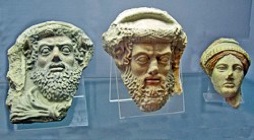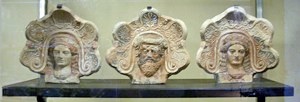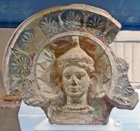


Athena in battle with Enceladus (ca. 520 BC)
From the East pediment of the Temple of Athena on the acropolis of Athens
Now in the new Acropolis Museum, Athens
Livy provided what is probably the earliest literary reference to a “temple of Nortia, a Tuscan goddess” at Velzna/ Volsinii. Archeological evidence for the cult is in the form of decorative elements from two temples (below) that were on the tufa rock of what is now Orvieto, but outside the Etruscan city:
-
✴the so-called Tempio di Vigna Grande (date? ); and
-
✴the so-called Tempio del Belvedere (ca. 500 BC).
In both cases, the goddess was depicted as Athena, based on the Athenian prototype illustrated above. Here Athena stands over the fallen Enceladus in the closing stages of the famous battle between Zeus and the giants (the Gigantomachy). She wears the aegis, the miraculous cloak that had been given to her by her father Zeus, and she originally held a spear in her left hand.
Virgil (Aeneid 8.435–8) described the aegis in a scene set in the workshop of Vulcan (Hephaestus):
“a chilling aegis, the breastplate of Pallas [Athena],
[the Cyclopes] competing to burnish its serpent scales of gold,
its interwoven snakes, and the Gorgon herself
on the goddess’s breast, with severed neck and rolling eyes”.
Although Virgil imagined the aegis as a breastplate, this representation of it as a cloak (as in the statue above) is more usual.
Tempio di Vigna Grande (?)
This temple, which no longer survives, is known from surviving decorative elements. These include fragments of a frieze (ca. 500 BC) depicting Athena (Minerva) defeating Enceladus. [Fragments at Orvieto and Toronto ??]
[In construction]
Tempio del Belvedere (ca. 500 BC)

[In construction]
The first indication of an important Etruscan cult site here came in 1527-32, when cult objects were found during the construction of the nearby Pozzo di San Patrizio. The remains of the temple itself were discovered during roadworks in 1828. Excavations in 1923 unearthed the floor plan and a number of column fragments. These revealed that the temple was of the classic design described by the Roman architect Vitruvius.
The temple was approached by a flight of steps that led to an open portico with two rows of four columns, and then to the tri-partite cella (three interior rooms). This tri-partite structure suggests that the temple had been a Capitolium (a temple dedicated to the Capitoline triad: Tinia/Jupiter; Uni/Juno; and Nortia/Minerva), and thus an obvious parallel of the temple of Jupiter Optimus Maximus in Rome. On this parallel, Nortia would have been venerated in the cella on the right (see below).
The excavations also unearthed a number of terracotta antefixes of exceptional quality, many of which are now in the museums of Orvieto (below). Most of these seem to have come from the back wall. Their dating on stylistic grounds points to the rebuilding or extensive redecoration of the temple in the late 5th or early 4th century BC. They seem to have been in situ when the temple was destroyed, probably at the time of the razing of Volsinii in 264 BC.
A similar tri-partite temple that has been revealed by aerial photography at Bolsena could have been a replacement for the Tempio del Belvedere that was built after the move to the new settlement there.
Tinia/ Jupiter
Three graffiti on pottery found at the site suggest that the temple was dedicated to Tinia:
-
✴two inscriptions (5th century BC), both on bucchero cups, recorded the epithet “apas” (of the father) - CIE 10525 and CIE 10535; and
-
✴a third (ca. 350 BC), on a black-figure cup, recorded “Tinia Calusna” - CIE 10560. The epithet “Calusna” means “of Calus”, an Etruscan deity linked to the underworld.
A slightly older graffiti inscription recorded the deity “Sur”, another Etruscan deity linked to the underworld - CIE 10537. (CIE 10525 and 10537 are illustrated in the paper by Giovanni Colonna referenced below, at Figures 3 and 4 respectively). [Where are these inscriptions now ??]
Nortia/ Minerva/ Athena
The tri-partite structure of the temple suggests that Nortia might have been worshipped in the area to the right as Nortia/ Minerva (since Minerva was in the space to the right in the Capitoline Temple in Rome). However, a votive offering (ca. 450 BC) from the temple (which is now in the Museo Civico - see below) suggests that Nortia was [also ?] worshipped here in an iconographic form derived from her Greek precursor, Athena.
Nortia and the Ritual of the Clavus Annalis
According to Livy, (who, in turn, citied his contemporary, the annalist Lucius Cincius Alimentus):
-
“... there were seen at [ancient] Volsinii nails fixed in the temple of Nortia, a Tuscan goddess, [which were used] as indices of the number of years” (‘Roman History’, 7:3:7).
Livy also described the introduction of this ritual the temple of Jupiter Optimus Maximus in Rome at the start of the Republic:
-
“Marcus Horatius, being consul [in 509 BC], according to law, dedicated the temple of Jupiter Optimus Maximus in the year after the expulsion of kings; the solemnity of fixing the nail was afterwards transferred from the consuls to the dictators, because theirs was a superior office. The custom being afterwards dropped, [an outbreak of plague in 364 BC] seemed a matter of sufficient importance [that] a dictator should be appointed. For which reason Lucius Manlius [was appointed ...” (‘Roman History’, 7:3:8)
Livy’s had just described the revived ritual
-
“Induced by this superstitious circumstance, the senate ordered a dictator to be appointed for the purpose of driving the nail. Lucius Manlius Imperiosus [was] appointed [for the purpose]. ... There is an ancient law that is written in antique letters and words [which was presumably kept in the temple], that whoever is “praetor maximus” should drive a nail on the ides of September [the anniversary of the temple’s dedication]. It was driven into the right side of the temple of Jupiter Optimus Maximus, on that part where the temple of Minerva is. They say that:
-
-the nail was a mark of the number of years elapsed [since its original dedication], because writing was rare in those times; and
-
-that the law was referred to the [part of the temple dedicated to] Minerva, because numbers are the invention of that goddess” (‘Roman History’, 7:3:4-5).
Francesco Roncalli (referenced below, p 225-7) observed:
-
“Each of the Etruscan cities must have had its own place where the passing years (and thus the beginning and end of the civic and religious calendar year) was officially registered and ritually sanctioned. It seems significant that only the tradition at Volsinii and the custodian of the rite there, Nortia (whom Livy promoted to the rank of ‘Tuscan goddess’) achieved fame in this context in the Roman world.
-
-Perhaps this was because the recording of time at Velzna had pan-Etruscan relevance, possibly because it recorded, among other things, the annual pan-Etruscan councils [at the nearby fanum Voltumna]?
-
-Perhaps the role of the priest who was elected by the ‘twelve people’ to preside over these annual councils was analogous to that of the “praetor maximus”at Rome, who - probably following the Etruscan tradition - drove the nail in the cella of Minerva, thereby entrusting ‘his’ year, its collegiate discussions and his own authority, to the inscrutable immutability of destiny ?” (my translation).
If the analogy is pursued to its logical conclusion, this would suggest that the annual driving of the nail at Velzna had taken place in the right-hand cella of the Tempio del Belvedere (which, as noted above, was analogous to the cella of Minerva in the temple of Jupiter Optimus Maximus at Rome).
This putative tradition would have come to an end at Velzna in 264 BC, when Velzna and its temples were destroyed. However, a number of bronze nails that were discovered along the southern wall of Temple A at the sanctuary at Campo della Fiera might point to the transfer of the tradition to this location. Simonetta Stopponi (referenced below, 2011) has concluded that:
-
“The most likely interpretation of [these] nails is for architectural terracottas, but the presence of such a large number of specimens raises the appeal to the Volsinian tradition of the clavus annalis, which was [originally] affixed to the temple of the goddess Nortia, recognised by some in the Orvietan Belvedere temple”.
Finds from the Temple
Inscriptions
To follow
Museo Civico
The following are in the Museo Civico:
Nortia ?/Athena (ca. 450 BC)

Virgil (Aeneid 8.435–8) described the aegis in a scene set in the workshop of Vulcan (Hephaestus):
“a chilling aegis, the breastplate of Pallas [Athena],
[the Cyclopes] competing to burnish its serpent scales of gold,
its interwoven snakes, and the Gorgon herself
on the goddess’s breast, with severed neck and rolling eyes”.
Although Virgil imagined the aegis as a breastplate, its representation as a cloak (as in the statue illustrated here) is more usual. The Gorgon that Virgil describes “on the goddess’s breast” is also clear visible on the bronze figure discussed here.
Bronze Votive Offerings (ca. 450 BC)

Terracotta Antefixes (ca. 400 BC)


The most impressive of these include:
-
✴a head of an old man (illustrated above);
-
✴a figure in high relief of a nude man in a cloak; and
-
✴a head of a gorgon (illustrated above).

A number of other lovely antefixes are displayed in a separate case.
Museo Archeologico Nazionale
The following are in the Museo Archeologico Nazionale:
Terracotta Figures (ca. 400 BC)

A number of terracotta figures discovered on the site include:
-
✴a splendid full length figure of a bearded God who is nonchalantly naked except for his cloak;
-
✴part of a figure in armour; and
-
✴part of a figure of a captive.
Terracotta Antefixes (ca. 400 BC)

The large number of decorative elements found on the site include these three particularly well preserved polychrome terracotta antefixes (one with a bearded male head and two with female heads).
Museo Archeologico, Perugia

Read more:
S. Stopponi , “Orvieto, Campo della Fiera: Fanum Voltumnae ”, in:
J. Macintosh Turfa (Ed.), “The Etruscan World”, (2013 ) Oxford, pp. 632-54
G. Colonna, “I Santuari Comunitari e il Culto delle Divinità Catactonie in Etruria”, in
G. della Fina (Ed.), “Il Fanum Voltumnae e i Santuari Comunitari dell’ Italia Antica”, (2012) pp 204-26
K. Busby, “The Temple Terracottas of Etruscan Orvieto: A Vision of the Underworld in the Art and Cult of Ancient Volsinii”, (2007) Illinois (Chapter 4).
G. della Fina and E. Pellegrini (ed), “Storia di Orvieto: Antichità”, (2003) Perugia:
F. Roncallii, “I Culti’, at pp 217-35
S. Stopponi, “Templi e l' Architettura Templari’, at pp 235-73
Return to Museums and Excavation Sites in Orvieto.
Return to Walk III.

